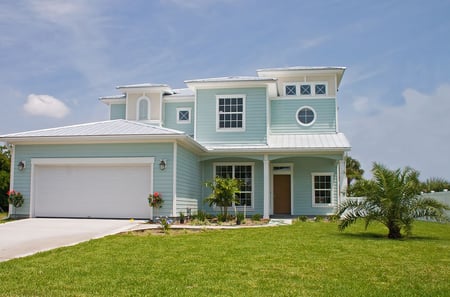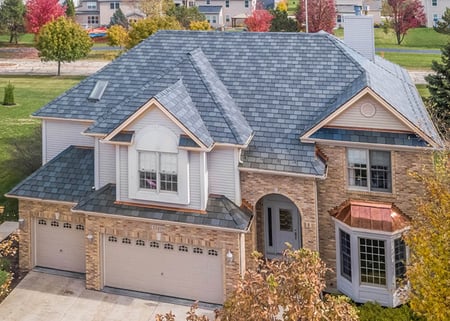Storm Resistance: Which Roof Is the Toughest?
June , 2024 | 8 min. read

When it comes to safeguarding your home, family, and belongings from the wrath of Mother Nature, the roof is your first line of defense. From torrential rains to hurricane-force winds, your choice of roofing material can make the difference between minor repairs and significant structural damage.
But with such a wide range of roofing options available, how do you determine which roof is the toughest in the face of severe weather? At RoofCrafters, we get it - there are so many great options, and it can be hard to choose the best fit.
That being said, stick around as we delve into the top contenders for storm-resistant roofing, examining their strengths, weaknesses, and overall effectiveness in weathering the storm. By the end of this article, you’ll have a better idea of what your home needs! Let’s get started.
Understanding Storm-Resistant Roofing

Before we dive into the specifics, it's crucial to understand what makes a roof storm-resistant. Storm resistance isn't just about withstanding strong winds; it also involves durability against heavy rains, hail, and even extreme temperatures. A storm-resistant roof should:
- Withstand high winds: Roofs should be able to resist uplift pressures and prevent wind from getting underneath and causing structural damage.
- Resist impact: Protection against hail, falling debris, and other impacts is crucial.
- Prevent water infiltration: Proper sealing and drainage to avoid leaks and water damage.
- Endure extreme temperatures: Resistance to cracking, warping, or other damage caused by temperature fluctuations.
Now, let's explore some of the leading roofing materials renowned for their storm resistance!
Asphalt Shingles: The Most Popular Choice

Strengths
Asphalt shingles are a favorite among homeowners, primarily due to their affordability and ease of installation. High-quality architectural shingles offer improved wind resistance compared to traditional 3-tab shingles. Many manufacturers rate their shingles to withstand wind speeds up to 130 mph, making them a viable option for regions prone to strong storms. Hello, Florida!
Weaknesses
Despite their popularity, asphalt shingles can suffer from damage due to hail or flying debris. Their longevity is also a concern, as they typically last 20-30 years, which is shorter than some other roofing materials.
Verdict
Asphalt shingles are a good middle-ground choice for moderate storm resistance. They are suitable for areas with occasional strong winds but may not be the best for regions frequently hit by severe storms.
Metal Roofing: Durability Meets Modern Style

Strengths
Metal roofing has gained a reputation for being one of the toughest options available. It can withstand wind speeds up to 160 mph, making it ideal for hurricane-prone areas. Metal roofs are also highly resistant to hail, withstanding impacts without cracking or denting. Additionally, metal roofs are fire-resistant and can last up to 70 years, offering long-term durability.
Weaknesses
The initial cost of metal roofing can be higher compared to other materials. Some homeowners may also find the noise from rain or hail hitting a metal roof to be bothersome, although this can be mitigated with proper insulation. Personally, I find it soothing!
Verdict
Metal roofing is a top contender for storm resistance. Its ability to handle high winds, hail, and extreme weather conditions makes it a reliable choice for storm-prone areas, despite the higher upfront cost.
Tile Roofing: Traditional Beauty with Resilience

Strengths
Tile roofing, whether clay or concrete, is known for its durability and aesthetic appeal. These roofs can withstand winds up to 150 mph and are highly resistant to fire. Tile roofs are also excellent for hot climates, as they provide good insulation and are impervious to rot and insect damage.
Weaknesses
The major drawback of tile roofing is its weight. Tiles are heavy, requiring a strong roof structure to support them. They can also be brittle, making them susceptible to cracking under impact from large hailstones or falling branches.
Verdict
Tile roofing offers good storm resistance, especially in terms of wind and fire. However, their weight and potential for impact damage make them less ideal in regions with frequent hailstorms or heavy debris.
Slate Roofing: The Timeless Protector

Strengths
Slate roofing is the gold standard for longevity and durability. A well-installed slate roof can last over 100 years and is resistant to fire, wind, and water. Slate can handle wind speeds up to 110 mph and is highly resistant to hail and other impacts.
Weaknesses
Like tile, slate is heavy and expensive. The installation process is complex, requiring skilled professionals to ensure proper placement and support. Additionally, the high cost of slate roofing can be prohibitive for many homeowners.
Verdict
Slate roofing is an excellent choice for storm resistance, especially for those who want a long-lasting solution. Its resistance to various weather conditions makes it a solid investment for homeowners in storm-prone areas, provided they can handle the cost and weight considerations.
Synthetic Roofing: The Modern Marvel

Strengths
Synthetic roofing materials, such as synthetic slate or composite shingles, are engineered to mimic the appearance of natural materials while offering superior durability. These materials can withstand wind speeds up to 120 mph and are highly resistant to impact damage. They are also lighter than natural materials, making them easier to install and less taxing on the roof structure.
Weaknesses
While synthetic roofing is durable, it may not match the longevity of natural slate or metal. The initial cost can also be high, though it is generally lower than natural slate.
Verdict
Synthetic roofing offers a balanced mix of durability, aesthetic appeal, and storm resistance. It’s a great option for those looking for a lightweight, resilient roofing material that can handle various weather conditions.
Flat Roofing: Practicality with Limitations

Strengths
Flat roofing systems, often seen on commercial buildings but also on modern homes, can be quite storm-resistant when properly installed. Materials like PVC or TPO membranes offer excellent water resistance and can be reinforced to withstand high winds. Flat roofs are also easy to maintain and repair, making them a practical choice for areas with frequent, less severe storms.
Weaknesses
Flat roofs can have drainage issues, making them less ideal in areas with heavy rainfall. Water pooling can lead to leaks and damage if not properly managed. They are also generally less resistant to strong winds compared to pitched roofs.
Verdict
Flat roofs can be storm-resistant if designed and maintained correctly. However, their limitations in water drainage and wind resistance make them less suitable for regions with severe weather conditions.
Choosing the Right Storm-Resistant Roof
When deciding on the toughest storm-resistant roof for your home, consider the specific weather patterns and risks in your area. Here are some key points to keep in mind:
- For high wind areas: Metal roofing and high-quality asphalt shingles are excellent choices due to their wind resistance.
- For hail-prone regions: Metal and synthetic roofs provide superior impact resistance compared to tile or asphalt shingles.
- For areas with heavy rainfall: Ensure proper sealing and drainage, particularly for flat roofs, and consider materials that resist water infiltration, like metal or synthetic roofing.
- For long-term investment: Slate and metal roofing offers unparalleled durability and longevity, making them ideal for homeowners looking for a lasting solution.
Ultimately, the toughest storm-resistant roof is one that meets your specific needs, balances cost and benefits, and provides peace of mind knowing your home is well-protected against the elements.
Whether you opt for the classic durability of slate, the modern resilience of metal, or the balanced performance of synthetic materials, investing in a storm-resistant roof is a decision that will pay dividends for years to come. If you’re ready to upgrade your home to help you and your family better weather the storm, be sure to hit the “Schedule an Inspection” button down below!
My name is Cassie, and I’m the Content Manager here at RoofCrafters. I was born and raised in Chicago, Illinois, and made my way out to Florida post-college graduation. I’m incredibly passionate about writing and creating valuable content that helps others with the collaboration of my marketing team. When I’m not working, I enjoy shopping (a little too much), spending time at the beach, and reading!



